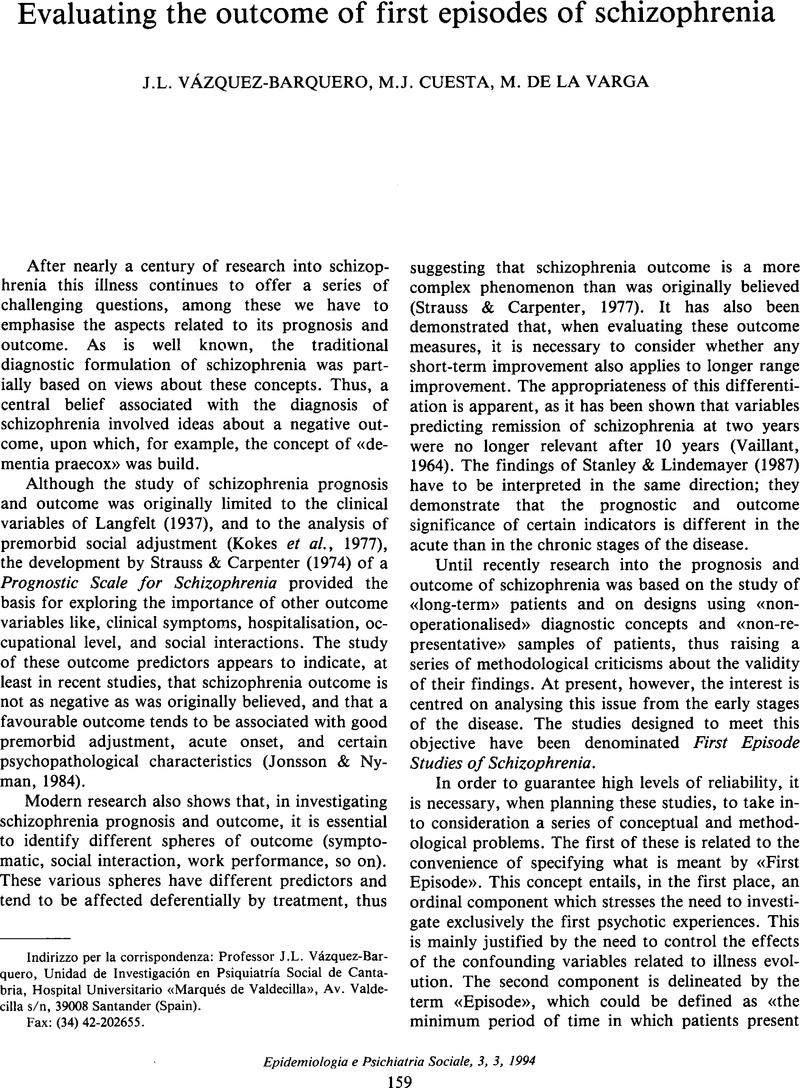No CrossRef data available.
Article contents
Evaluating the outcome of first episodes of schizophrenia
Published online by Cambridge University Press: 11 October 2011
Abstract
An abstract is not available for this content so a preview has been provided. As you have access to this content, a full PDF is available via the ‘Save PDF’ action button.

- Type
- Editorials
- Information
- Copyright
- Copyright © Cambridge University Press 1994
References
Bergner, M., Bobbit, R.A. & Pollard, W.E. (1976). The sickness impact profile: validation of a health status measure. Medical Care 14, 157–179.CrossRefGoogle ScholarPubMed
Gulbinat, W. (1983). Mental health problem assessment and information support direction of the WHO's work. World Health Statistics Quarterly 36, 224–233.Google ScholarPubMed
Hafner, H. (1991). New perspectives in the epidemiology of schizophrenia. In Search for the Causes of Schizophrenia, Vol. 2. (ed. Hafner, H. and Gattaz, W.F.), pp. 408–431. Springer: Berlin.CrossRefGoogle Scholar
Iacono, W. & Beiser, M. (1992). Where are the women in First-Episode Studies of Schizophrenia? Schizophrenia Bulletin 3, 471–480.CrossRefGoogle Scholar
Jablensky, A, Sartorius, N., Ernberg, G., Anker, M., Korten, A., Cooper, J.E., Day, R. & Bertel, A. (1992). Schizophrenia: manifestations, incidence and course in different cultures. A World Health Organization Ten-Country Study. Psychological Medicine, Supplementum No. 20, pp. 3–97.Google Scholar
Johnstone, E.C., MacMillan, J.F., Frith, C.D., Benn, D.K. & Crow, T.J. (1990). Further investigation of the predictors of outcome following first schizophrenic episodes. British Journal of Psychiatry 157, 182–189.CrossRefGoogle ScholarPubMed
Jonsson, H. & Nyman, A.K. (1984). Prediction of outcome in schizophrenia. Ada Psychiatrica Scandinavian 69, 274–279.CrossRefGoogle ScholarPubMed
Keshavan, M.S. & Schooler, N.R. (1992). First-episode studies in schizophrenia: criteria and characterization. Schizophrenia Bulletin 18, 491–513.CrossRefGoogle ScholarPubMed
Kokes, R.F., Strauss, J.S. & Klormant, R. (1977). Part II. Measuring premorbid adjustment: the instruments and their development. Schizophrenia Bulletin 3, 186–213.CrossRefGoogle ScholarPubMed
Krawiecka, M., Goldberg, D.P. & Vaughan, M. (1977). A standardized psychiatric assessment scale for rating chronic psychotic patients. Acta Psychiatrica Scandinavica 55, 299–308.CrossRefGoogle ScholarPubMed
Langfelt, G. (1937). The prognosis of schizophrenia and the factors influencing the course of the disease. Acta Psychiatrica Neurologica Scandinavica, Supplementum No. 13.Google Scholar
Montgomery, S.A., Taylor, P. & Montgomery, D. (1978). Development of a schizophrenia scale sensitive to change. Neuropharmacology 17, 1061–1063.CrossRefGoogle ScholarPubMed
Patrick, D.L., Bush, J.W. & Chen, M. (1973). Methods of measuring levels of well-being for a health status index. Health Service Research 8, 228–231.Google ScholarPubMed
Ram, R., Bromet, E.J., Eaton, W.W., Pato, C. & Schwartz, J.E. (1992). The natural course of schizophrenia: a review of firstadmission studies. Schizophrenia Bulletin 18, 185–207.CrossRefGoogle ScholarPubMed
Ring, N., Tantam, D., Montague, L.Newby, D., Black, D. & Morris, J. (1991). Gender differences in the incidence of definite schizophrenia and atypical psychosis: focus on negative symptoms of schizophrenia. Ada Psychiatrica Scandinavica 84, 489–496.CrossRefGoogle ScholarPubMed
Sartorius, N., Jablensky, A., Korten, A., Ernberg, G., Anker, M., Cooper, J.E. & Day, R. (1986). Early manifestations and firstcontact incidence of schizophrenia in different cultures. Psychological Medicine 16, 909–928.CrossRefGoogle ScholarPubMed
The Scottish Schizophrenia Research Group (1987). The Scottish first episode schizophrenia study. I. Patient identification and categorisation. British Journal of Psychiatry 150, 331–333.CrossRefGoogle Scholar
Shepherd, M., Watt, D., Falloon, I. & Smeeton, N. (1989). The natural history of schizophrenia: a five-year follow-up study of outcome and prediction in a representative sample of schizophrenics. Psychological Medicine, Supplementum No. 15, pp. 1–46.CrossRefGoogle Scholar
Stanley, R.K. & Lindemayer, J.P. (1987). Outcome predictors in acute schizophrenia. Prospective significance of background and clinical dimensions. The Journal of Nervous and Mental Disease 175, 152–160.Google Scholar
Strauss, J.S. & Carpenter, W.T. (1974). Prediction of outcome in schizophrenia: II. Relationships between predictor and outcome variables. Archives of General Psychiatry 31, 37–42.CrossRefGoogle ScholarPubMed
Strauss, J.S. & Carpenter, W.T. (1977) Prediction of outcome in schizophrenia. III. Five-year outcome and its predictors. Archives of General Psychiatry 34, 159–163.CrossRefGoogle ScholarPubMed
Vaillant, G. (1964). Prospective prediction of schizophrenic remission. Archives of General Psychiatry 11, 509–518.CrossRefGoogle ScholarPubMed
Vazquez-Barquero, J.L., Cuesta, N.J., Varga, M., Herrera, Castanedo S., Gaite, L. & Arenal, A. (1994). The Cantabria first episode schizophrenia study: a summary of general findings. Ada Psychiatrica Scandinavica (accepted for publication).Google Scholar
Wiersma, D., De Jong, A. & Kraaijkamp, H.J.M. (1990). The Groningen Social Disabilities Schedule. 2nd Version. University of Groningen. Department of Social Psychiatry: Groningen.Google Scholar
Wing, J.K. & Sturt, E. (1978). The PSE-ID-CATEGO System: a Supplementary Manual. Institute of Psychiatry: London.Google Scholar
Wing, J., Cooper, J.E. & Sartorius, N. (1974). Measurement and Classification of Psychiatric Symptoms. Cambridge University Press: Cambridge.Google Scholar
World Health Organization (1988). Psychiatric Disability Schedule (WHO/DAS). WHO: Geneva.Google Scholar
Wykes, T. & Sturt, E. (1986). The measurement of social behaviour in psychiatric patients: an assessment of the reliability and validity of the SBS schedule. British Journal of Psychiatry 148, 1–11.CrossRefGoogle ScholarPubMed


